.

Insulators and transmission wires in the switchyard of the TVA's
Chickamauga Dam, located near Chattanooga, 471 miles above the mouth
of the Tennessee River. The [dam] has an authorized power installation
of 81,000 kw. The reservoir at the dam adds 377,000 acre-feet of water
to controlled storage on the Tenn. River system. The power that passes
through this switchyard serves many useful domestic, agricultural and
industrial uses: photo by Alfred T. Palmer, June 1942 (Farm Security Administration/Office of War Information Collection, Library of Congress)
And before hell mouth
the gate swung on its hinges,
heard in the dream
by chance a name,
a riddle of the past
states that
an intruder in a strange house
is discovered; falling plaster
reveals the place
missing object from the
......stranger,
asleep.
a strange house in
an electrical storm
vanishes and the site becomes
a wound, a terrible
.dream driving,
.......no nearer home than
a spooky
......house
a strange experience among a people weirdly
.......deluded
the secret of the delusion
......obtained in
..psychic shock.
a dream, or an unusual experience
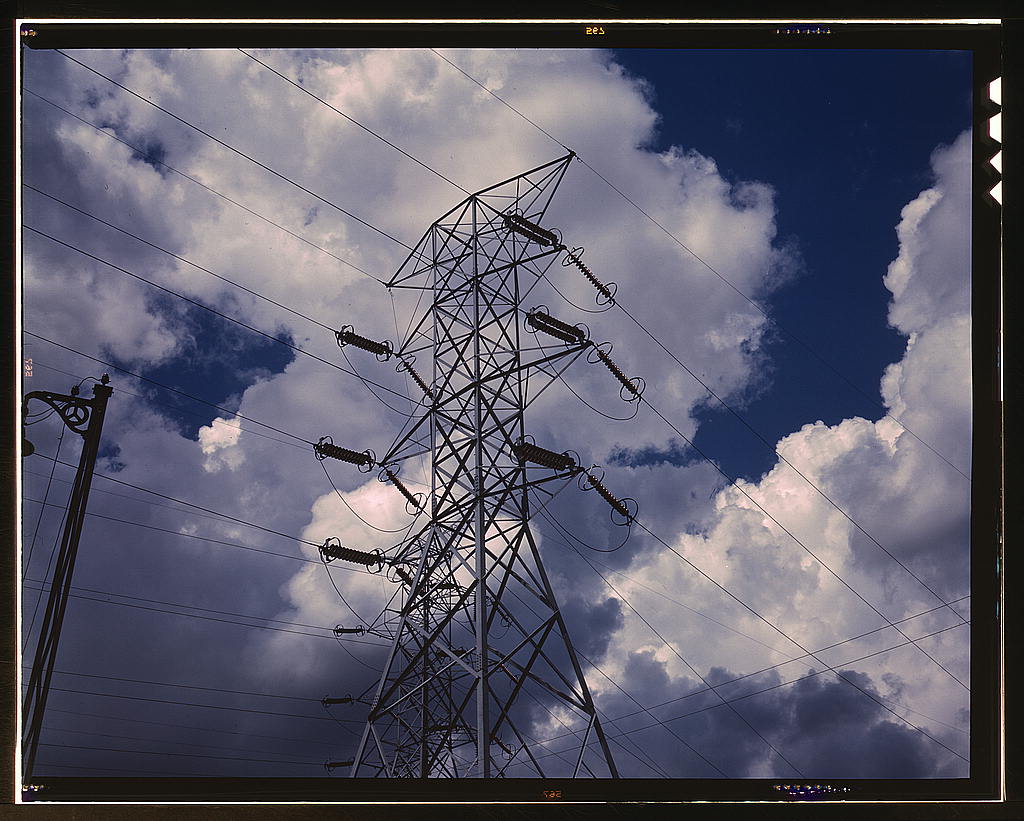
Transmission towers in the switchyard of TVA's Chickamauga Dam, near Chattanooga, Tennessee: photo by Alfred T. Palmer, June 1942 (Farm Security Administration/Office of War Information Collection, Library of Congress)
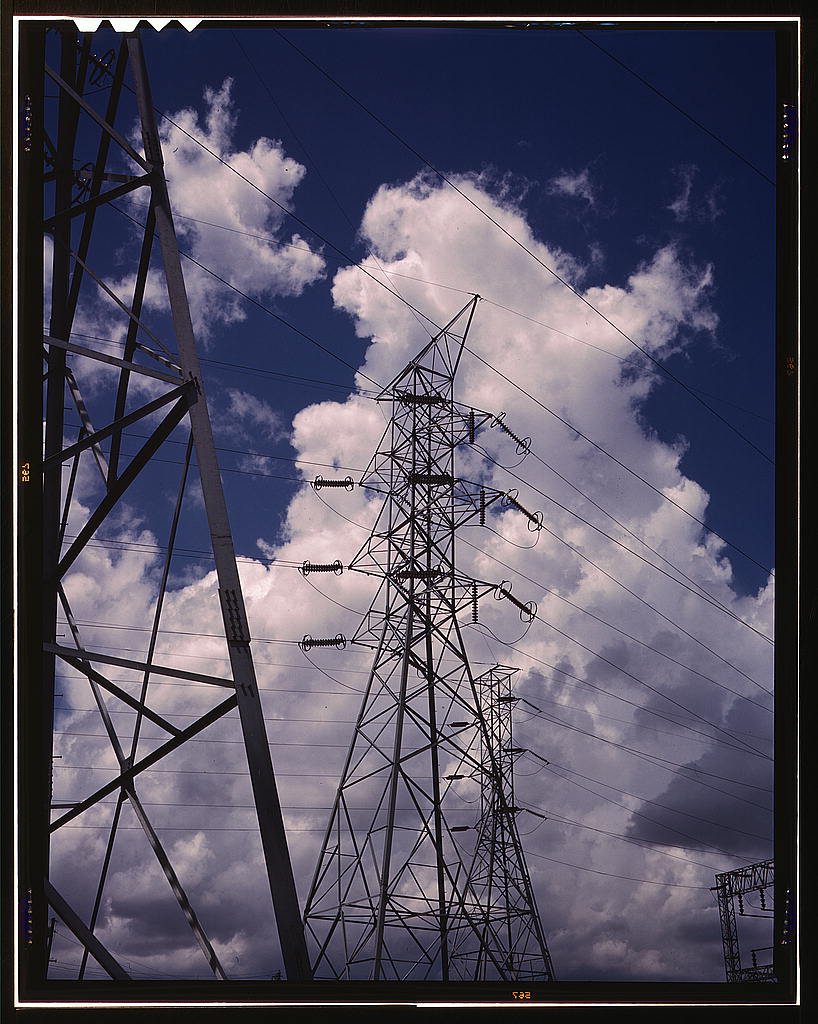
Transmission towers in the switchyard of TVA's Chickamauga Dam, near Chattanooga, Tennessee: photo by Alfred T. Palmer, June 1942 (Farm Security Administration/Office of War Information Collection, Library of Congress)

Untitled (Jesus Bazaldua Barber, a telecommunications engineer for Telefonos de Mexico, fatally electrocuted by more than 60,000 volts whilst installing a new phone line on the 13th km. of the Mexico City-Toluca highway): photo by Enrique Metinides, 1971 (via American Suburb X)

Untitled (This is a picture of one of so many poor people who, to this day, continue to steal electricity in Mexico City. They connect a cable to their home and then climb up the post to hook into the system, but they often get electrocuted): photo by Enrique Metinides, n.d. (via American Suburb X)

The execution of Ruth Snyder in the electric chair at Sing Sing Prison, Ossining, New York, 12 January 1928: photo by Tom Howard for New York Daily News (image by RaseaC, 7 July 2010)
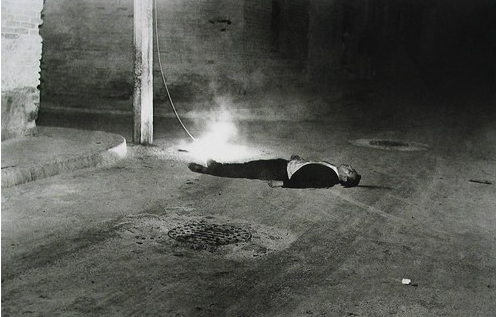
A High Voltage Cable Snaps Loose and Hits a Man Walking Along Tacaba Street. Despite Being Badly Electrocuted, He Survived: photo by Enrique Metinides, 1958 (Museum of Modern Art, via American Suburb X)

Fort Knox. Electric power line construction. Linemen, the "broadbacks" of the electrical industry, extend a new power line to Fort Knox, Hardin County, Kentucky, where American soldiers are training and hardening for the battles of democracy: photo by Alfred T. Palmer, June 1942 (Farm Security Administration/Office of War Information Collection, Library of Congress)

Fort
Knox. Electric power line construction. Linemen, the "broadbacks" of
the electrical industry, extend a new power line to Fort Knox, Hardin
County, Kentucky, where American soldiers are training and hardening for
the battles of democracy: photo by Alfred T. Palmer, June 1942 (Farm Security Administration/Office of War Information Collection, Library of Congress)

Fort
Knox. Electric power line construction. Linemen, the "broadbacks" of
the electrical industry, extend a new power line to Fort Knox, Hardin
County, Kentucky, where American soldiers are training and hardening for
the battles of democracy: photo by Alfred T. Palmer, June 1942 (Farm Security Administration/Office of War Information Collection, Library of Congress)

Fort
Knox. Electric power line construction. Linemen, the "broadbacks" of
the electrical industry, extend a new power line to Fort Knox, Hardin
County, Kentucky, where American soldiers are training and hardening for
the battles of democracy: photo by Alfred T. Palmer, June 1942 (Farm Security Administration/Office of War Information Collection, Library of Congress)

Fort Knox. Electric power line construction. The electrical industry of America relies largely on the "broadback" or lineman,
to bring its power to the places where it is needed. This man is
working on the construction of a transmission line to Fort Knox,
Kentucky, where American soldiers are training for the battles of
democracy: photo by Alfred T. Palmer, June 1942 (Farm Security Administration/Office of War Information Collection, Library of Congress)

Telephone system used in fighting forest fire. Withlacoochee Land Use Project, Florida: photo by Arthur Rothstein, February 1937 (Farm Security Administration/Office of War Information Collection, Library of Congress)

Greenville,
South Carolina. Air Service Command. Men of the 1067th signal company
of the 25th service group stringing telephone wire: photo by Jack Delano, July 1943 (Farm Security Administration/Office of War Information Collection, Library of Congress)

Telephone linemen, U.S. Highway 80, Texas, between Fort Worth and Dallas: photo by Arthur Rothstein, January 1942 (Farm Security Administration/Office of War Information Collection, Library of Congress)

Hayti, Missouri. U.S. Rural Electrification Administration (REA) cooperative lineman: photo by Arthur Rothstein, July 1942 (Farm Security Administration/Office of War Information Collection, Library of Congress)

Telephone linesmen raising wires to keep them above the flood level. Near Cache, Illinois: photo by Russell Lee, February 1937 (Farm Security Administration/Office of War Information Collection, Library of Congress)

Lineman on telephone pole at the Casa Grande Valley Farms, Pinal County, Arizona: photo by Russell Lee, April 1940 (Farm Security Administration/Office of War Information Collection, Library of Congress)

Portrait of America. No. 36. Rural electrification in the U.S. Far out on the western plains of America a lineman adjusts the top wire of a rural electrification project which will bring power and light to remote U.S. farms and communities miles from the nearest power plant. U.S. farmers' cooperatives are organized to secure rural electrification at cost on a non-profit basis. There are over 6,000,000 farms in America and more than four out of every ten are now electrified. [FSA caption]: photo by Russell Lee, May 1941 (Farm Security Administration/Office of War Information Collection, Library of Congress)

Lineman, electrical. Canyon County, Colorado [Lee caption]: photo by Russell Lee, May 1941 (Farm Security Administration/Office of War Information Collection, Library of Congress)

Lineman, electrical. Canyon County, Colorado: photo by Russell Lee, May 1941 (Farm Security Administration/Office of War Information Collection, Library of Congress)

Plant construction. Denver ordnance plant, Denver, Colorado. Lineman bringing power to the ordnance plant at Denver, Colorado, which will produce small arms ammunition: photo by Russell Lee [?], June 1941 (Farm Security Administration/Office of War Information Collection, Library of Congress)
Longview, Texas to Arkansas state line. War emergency pipeline from Longview, Texas to Norris City, Illinois. Replacing telephone wires which were removed when the pipeline was laid: photo by John Vachon, October 1942 (Farm Security Administration/Office of War Information Collection, Library of Congress)

Telephone wires, Rosslyn, Virginia: photo by John Vachon, July-August 1937 (Farm Security Administration/Office of War Information Collection, Library of Congress)

Telephone wires, Tygart Valley, West Virginia: photo by John Vachon, June 1939 (Farm Security Administration/Office of War Information Collection, Library of Congress)

Tennessee Valley Authority. Pole line carrying 110-volt current
generated at TVA's hydroelectric plant at Wilson Dam. Located near
Sheffield, Alabama, 260 miles above the mouth of the Tennessee River,
the dam has an authorized power installation of 288,000 kilowatts, which
can be increased to a possible ultimate of 444,000 kilowatts. The
reservoir at the dam adds 377,000 acre-feet of water to controlled
storage on the Tennessee River system: photo by Alfred T. Palmer, June 1942 (Farm Security Administration/Office of War Information Collection, Library of Congress)

Tennessee Valley Authority. Transmission line towers and high-tension lines
that carry current generated at the TVA's hydroelectric plant at Wilson
Dam. Located near Sheffield, Alabama, 260 miles above the mouth of the
Tennessee River, the dam has an authorized power installation of
288,000 kilowatts, which can be increased to a possible ultimate of
444,000 kilowatts. The reservoir at the dam adds 377,000 acre-feet of
water to controlled storage on the Tennessee River system: photo by Alfred T. Palmer, June 1942 (Farm Security Administration/Office of War Information Collection, Library of Congress)

Power and conservation. Chickamauga Dam, Tennessee Valley Authority (TVA). The new 154,000 volt transmission line
running from the TVA's Chickamauga Dam. The dam, located near
Chattanooga, 471 miles above the mouth of the Tennessee River, has an
authorized power installation of 81,000 kilowatts, which can be
increased to a possible ultimate of 108,000 kilowatts. The reservoir at
the dam adds 377,000 acre feet of water to controlled storage on the
Tennessee River system. The power that travels along this line serves many useful domestic, agricultural and industrial uses: photo by Alfred T. Palmer, June 1942 (Farm Security Administration/Office of War Information Collection, Library of Congress)
Transmission line towers and high tension lines: photo by Alfred T. Palmer, June 1942 (Farm Security Administration/Office of War Information Collection, Library of Congress)

Statue of Mictlantecuhtli, Aztec god of the dead, museum of the Templo Mayor, Mexico City : photo by Jamie Dwyer, 19 August 2008
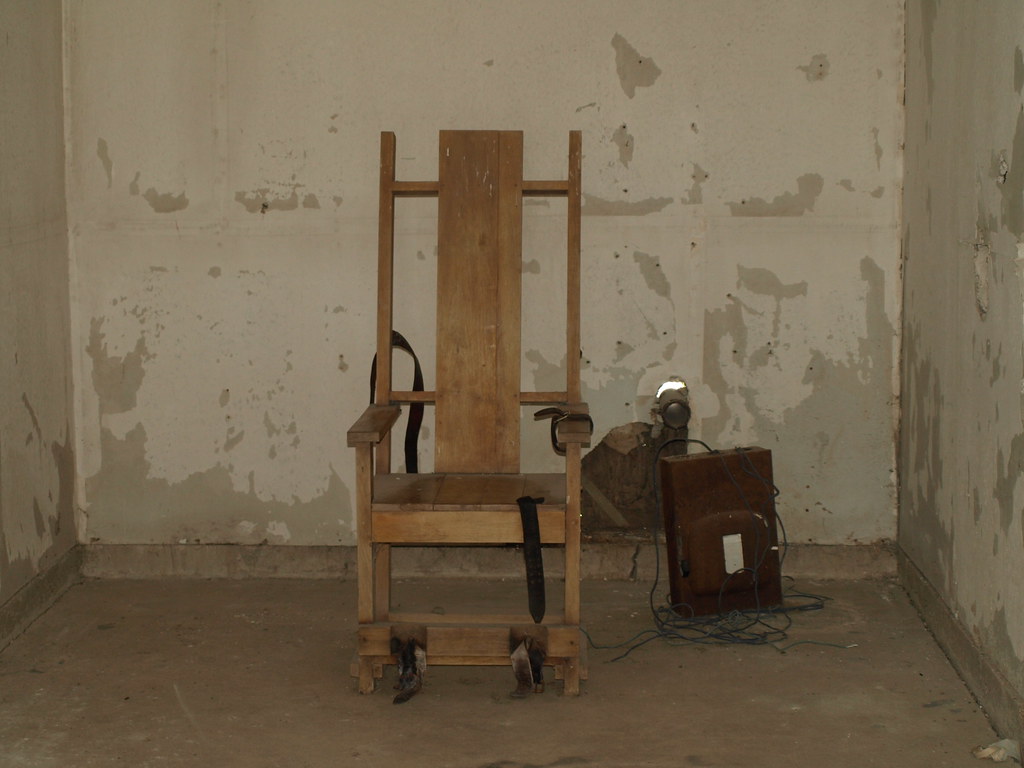
Original Death Chamber at the Red Hat Cell Block, Louisiana State Penitentiary; the chair is a replica of the original (the Red Hat was closed in the early 1970s): photo by Lee Honeycutt, 28 March 2010
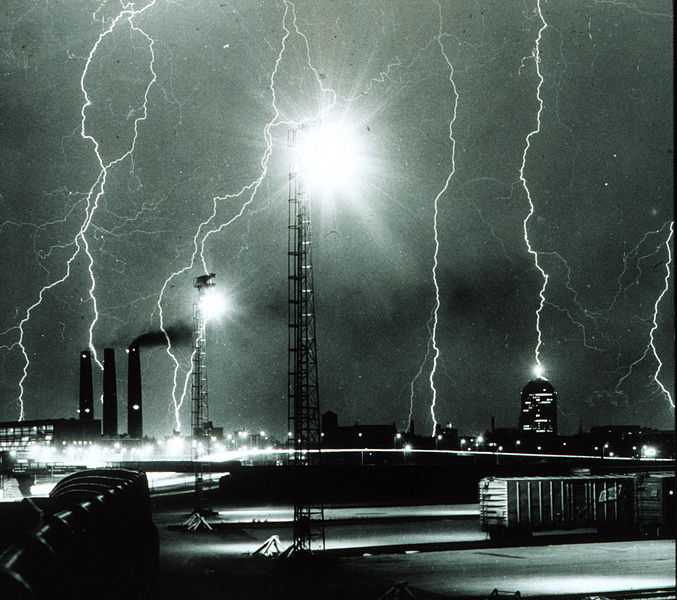
Lightning storm over Boston: photo by Boston Globe, 1967 (NOAA)

Lightning striking the Eiffel Tower, June 3, 1902: from Tonnerre et éclairs, Camille Flammarion (image via NOAA, 2000)
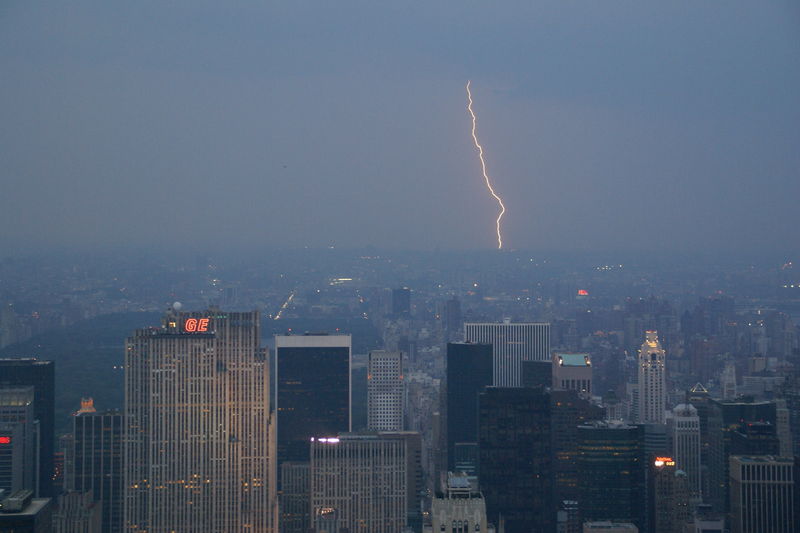
Lightning strikes on the Bronx viewed from the Empire State Building, New York City: photo by Hermann Luykin, 7 June 2008
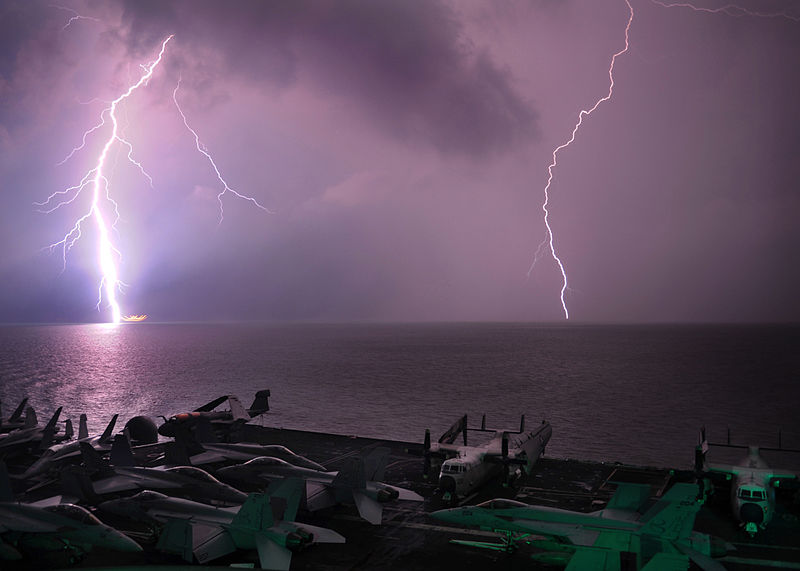
Lighting flashes as the aircraft carrier USS Abraham Lincoln (CVN 72) transits the Strait of Malacca, underway on a scheduled deployment to the U.S. 7th and U.S. 5th Fleet areas of responsibility: photo by Mass Communication Specialist 3rd Class Colby K. Neal (U.S. Navy)

Time-lapse capture of multiple cloud-to-ground lightning strokes during a night-time thunderstorm, Norman, Oklahoma: photo by C. Clark, March 1978 (NOAA Photo Library/National Severe Storms Laboratory)

San Francisco/Oakland Bay Bridge Lightning Strike: photo by Phil McGrew, 12 April 2012
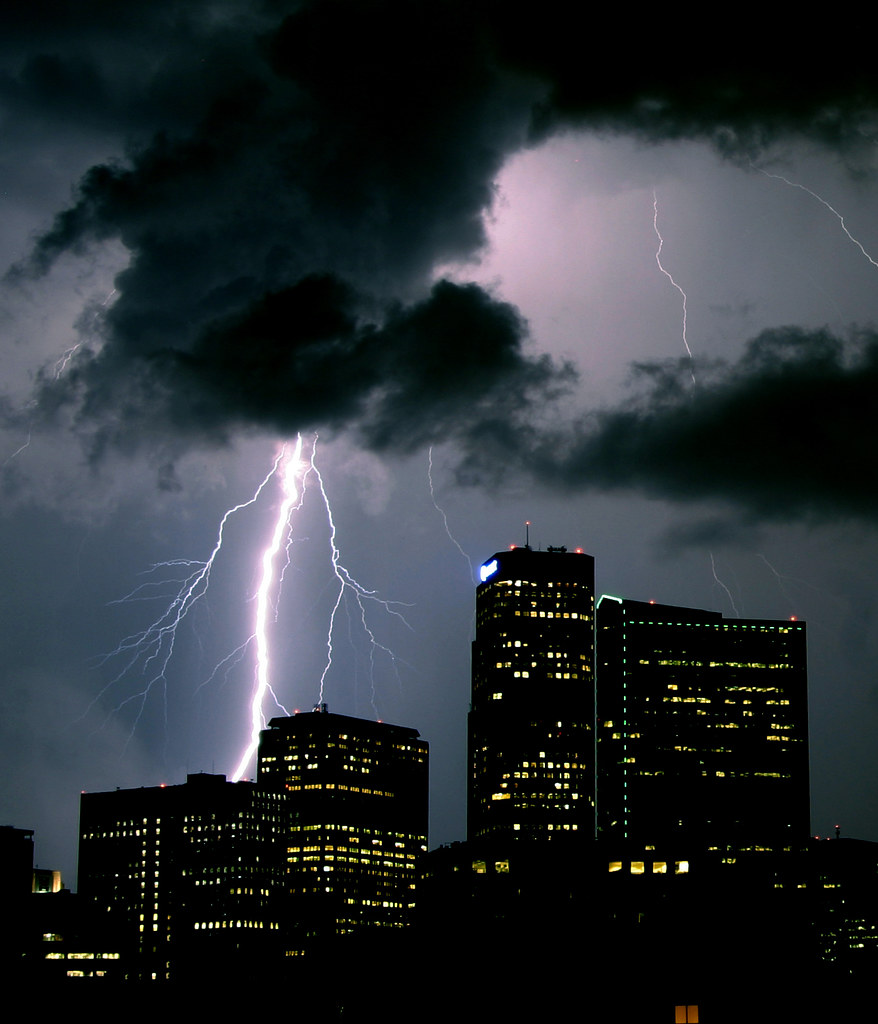
A large bolt of lightning strikes west of downtown Denver, with Qwest Tower in plain view: photo by Dag Peak, 8 June 2004
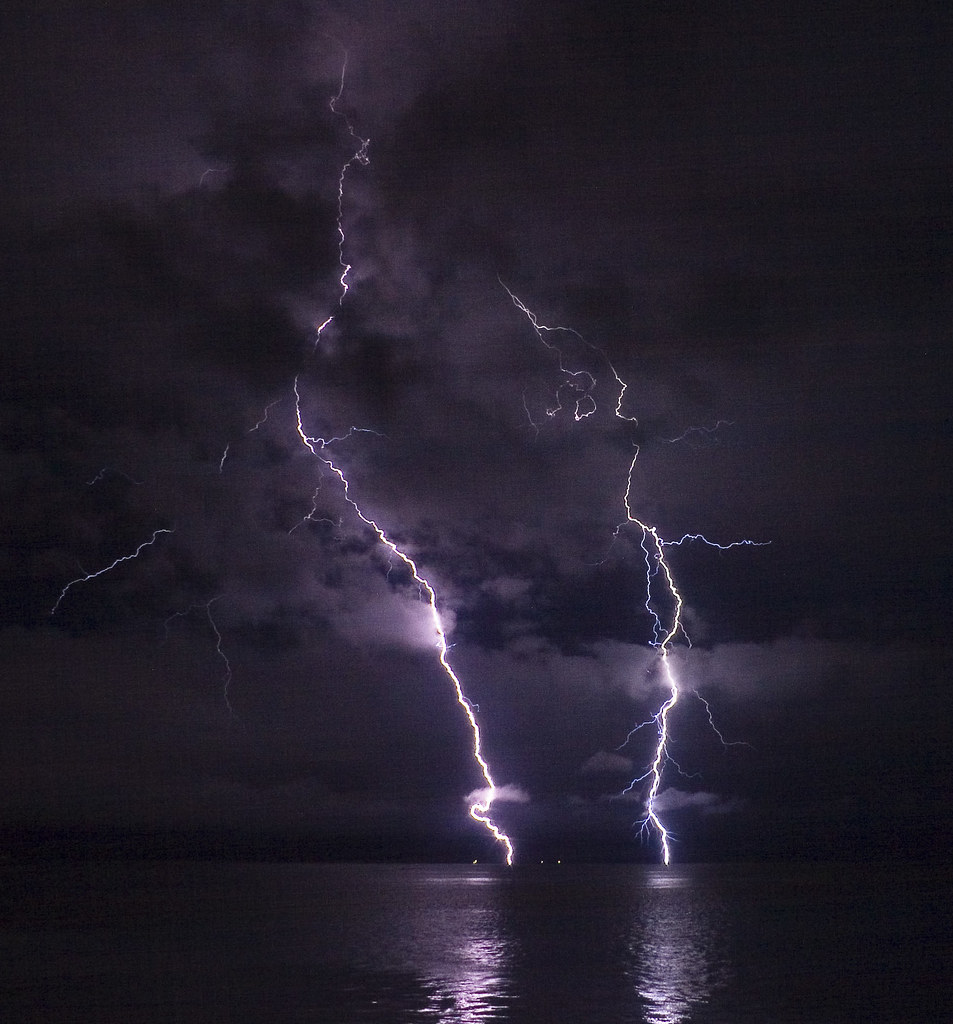
Lightning over the Columbia River, Oregon: photo by Ian Boggs, 16 August 2007
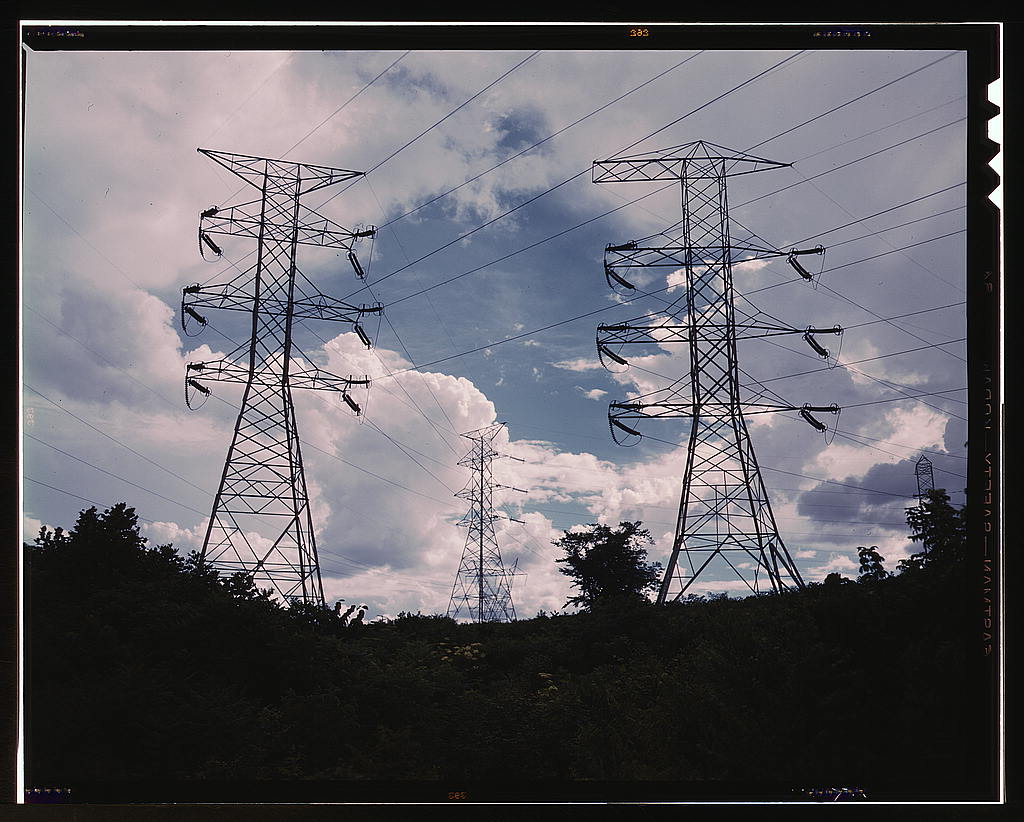
Transmission line towers and high tension lines that carry current generated at TVA's Wilson Dam hydroelectric plant, near Sheffield, Alabama: photo by Alfred T. Palmer, June 1942 (Farm Security Administration/Office of War Information Collection, Library of Congress)


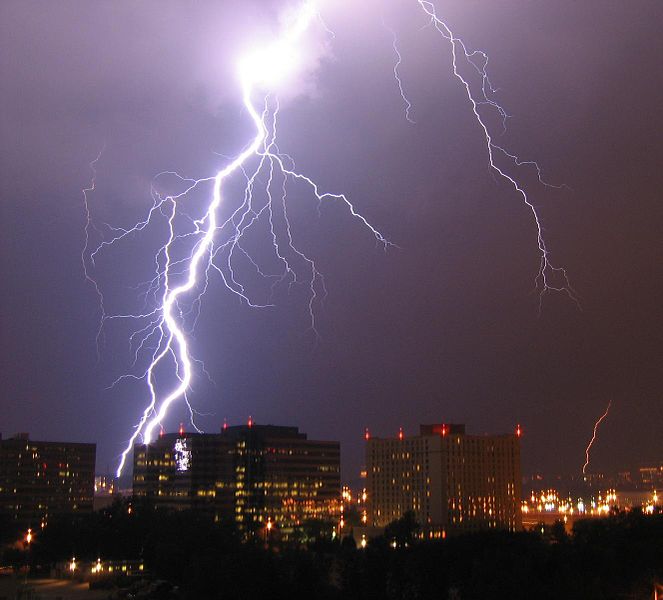



18 comments:
In this post several Enrique Metinides studies of Holy Dying, XX c. style, have been imbedded within a larger millennial atmosphere of grid lock and grid disturbance. Dying is so slow, normally. But the fast kind would have something to say for it. Really it's so, so close. The last thing might simply be the next thing. In consideration of that fact I would see Enrique Metinides, in his careful objectivity, as a deeply religious artist.
Macabre dance of iconography and death.
I can't help seeing the same thing in the equally macabre dance of the iPhone user stupidly transfixed on a screen too small too read, too small to write
Enrique Metinides: 50 años en la frente policia
I will be with this one all weekend, I'm sure. It's like a great big gallery show in one post on one big screen in my mind. I think you, the photographers and Aram Saroyan have pulled something rather moving and profound together here. Curtis
Thanks, Curtis.
I had shown Aram a Metinides shot that had been haunting me of late. Car crash, Mexico City. That shot had been edited out of a post mid last month (An Actuality) due to Internal Affairs. Aram encouraged a return to the scene of the crimescene photographer (as it were). This has allowed me to pass off a bit of the blame for the present perpetration to him.
The direct observation that became the foundation of this post came (however) not so much from art as from life, the watching of the installation of a new utilities pole out front, a few months back. That took four crews of six to eight men per crew, manning enormous cranes and rigs.
It is impressive to see that less manpower was once required in such operations. But that "broadback" work remains remarkable all the same. And certainly perilous enough. What looked like Saint Elmo's fire dancing about the high tension lines, at one point. One could easily enough get fried to a crisp in a careless moment, doing that kind of work.
And the photographers documenting it 70-75 years ago were of course doing so from below. Their POV imposes a reverential tone upon these photos, in which we are looking skyward as toward a heaven pierced by the industrious spires of Power.
Each photographer within this unified format retains an individuality of style of course.
Perhaps the style most suitable to the subject matter is indeed that of Alfred T. Palmer, whose gorgeous colour hymns to war production curiously remind of the high style of Leni Riefenstahl.
That barocco period of the OWI differs so much in both message and method from what had come before wth the FSA. The shift is notably evident with the "bump" that occurs in the segue from Palmer's propaganda series on the new power line to Fort Knox, and Arthur Rothstein's linesmen from the Withlacoochee Land Use Project. Just five years earlier, but another world of intent and purpose altogether.
Tom,
"atmosphere of grid lock and grid disturbance"
"The last thing might simply be the next thing."
"looking skyward as toward a heaven pierced"
5.4
light coming into sky above still black
plane of ridge, robin calling on branch
in foreground, wave sounding in channel
approximation of particular,
is equivalent to this
which define line, inserted
here, which intersect
grey white of fog against top of ridge,
circular green pine on tip of sandspit
Tom, So much in this post stirs the mind this morning. A ‘macabre dance’ indeed. Starting out, I was a police reporter in Forth Worth, then nicknamed Little Chicago, for it’s numerous shootings, gangland and otherwise; they seem unremarkable today when compared to the daily bloodlettings in Anywhere, USA. Saw death in various formats, but nothing like Metinides or Weegee. They were drawn to that duty. I was assigned to it. I preferred the interview, and the feature story, so my editors groused about what they perceived as my sympathy for criminals. I saw them for what, quite often, they were: people with big problems and few resources, ruled by their passions, frequently getting stiffed by circumstance. Hard boiled I wasn’t. Maybe we had a better class of criminal back then. Just kidding.
In seventh grade, one day after school, another student climbed a power pole next to the playing fields, intent on stealing the copper wiring. Instead, what he got was electrocuted. Learning of that the next day left its impress on my young psyche more than death in Forth Worth. If stupidity were a fuel, we’d have an endless supply of energy.
“a strange experience among a people weirdly
.......deluded.”
God, I like that.
The next thing
might simply be the last thing
The last thing simply the next
Hmmmm
A strange thing a life
but ultimately precious
Thanks Tom
My physics teacher said that it takes more power, or voltage, or whatever the technical term is (he didn't use those words), to send the electricity along wires that are buried underground, than it would if the wires are suspended in mid air. So I think that's why they do it that way, even though it's like having your bloodstream surface-mounted on the outside of your skin.
In Britain they recently had a competition to design a new electricity pylon. The current ones were designed in the twenties and they felt it was time for a change, I suppose. I didn't really like any of the solutions, they aren't worth a link, but it's an interesting thing to think about. There's that Icelandic one, I'm sure you'll have seen it: http://www.choishine.com/port_projects/landsnet/sshot-1-jin%27s.jpg
Artur,
White Sands, east of Truth or Consequences
Hazen,
So obviously you are in familiar territory with "The Greek" (as Metinides was called in his working days).
Obviously that's not a beat for the faint of heart, in any place, at any time.
About that potentially limitless energy supply -- now you're talking!
Colin,
Yes, the precious aspect of the gift has never been more in my mind than in these weeks since my sudden brush with mortality resulting in the endless night of head surgery and scans at the Trauma Center, a place where the gift of course is/was not taken for granted. In fact, in the present situation the extreme fragility of the gift turns out to be a bit hard not to continue to dwell upon, like that proverbial 800 pound gorilla. On the other hand, when someone here says, re. this post, "You're just obsessed with Death!" one does grasp that the concentration may well appear quite tiresome indeed. But just as there was some doubt for the Fatal Accident Investigation Team at the site of the crimescene, there lingers in the mind some doubt, these continuing long nights, as to exactly which side of the border one is riding on, at any given moment.
Artur,
Well, there seems to be some debate in some areas of the planet on the wisdom of transmitting power through high-voltage aerial cables.
The aerial hardware in the grid systems currently in place resembles that in the Alfred T. Palmer photos so closely as to suggest the design may be considered eternal, like a Platonic Idea. Here for example are pylons carrying high voltage lines over the Columbia River, in the state of Washington.
These extra-high voltage transmission lines appear as the thick magenta arterial networks in the map of the United States Transmission Grid.
The perceived drawbacks to overhead cables would be both aesthetic (they are about as attractive a feature of any countryside as would be your average Triffd) and practical (they are subject to damage by lightning, wind and freezing; they emit potentially harmful electromagnetic fields into the surrounding location; they are hazardous to wildlife and low flying aircraft; they pose, obviously, the significant hazard of accidental electrical shock to humans; and they are increasingly considered to be vulnerable to deliberate sabotage and armed conflict, not to mention your garden variety conductor theft and other forms of illegal connection -- which is what brought sudden death upon those unfortunates in Mexico City, pictured in the Metinides image).
Cost of course is the primary obstacle to undergrounding transmission lines. Burying high voltage transmission cables increases the cost of installation, on average, by a factor ranging from 2x to 4x depending on the location. In dense urban areas that factor can go up as high as 12-14x. There are also the operational issues involved with controlling large charging currents underground, potentially making voltage control unstable.
Still there are places where undergrounding is happening. Here for example is a former pylon transformer south of Markgröningen, Germany. Today, the pylon carries only a switch fed by two underground cables. It's certainly a lot less scary looking than those giant Triffids galloping across the landscapes.
Though it must be conceded that those gigantic Icelandic Mechano Men you have shown us are almost as pleasant to look at as huge lovely frosted Christmas trees. Of course, that's looking from a great distance. In fact, in our case here, from a world away. I don't know that I would wish to place my reindeer herd in amongst the feet of the pylons, however. Nor my goats either for that matter!
Interesting map, that. They're very dangerous, of course.
Here's the winning one in the competition; but you really ought to look at the other entries, some are hideous and have given me nightmares.
What do you think about wind turbines? They're lovely on their own, but having wind-farm pylons everywhere is not going to be pretty.
Artur.
Artur,
I'll have to say the Danish T-Pylon has it all over the other entrants in terms of basic design simplicity.
The anthropomorphic and entomologomorphic (?) conceptions, on the other hand, do leave one with that off-putting Triffid-in-the-room sensation.
Wind turbines of course make a lot of sense, especially (obviously) in places where there is a lot of wind.
The moorlands and coasts of Scotland and Wales come to mind. What with Energy Independence being a serious political issue for the Scots, and all. And the North Sea is of course a natural wind field, I see Belgium has in fact installed turbines to reap that.
My favourite wind turbine design (perhaps not surprisingly) is the least imposing and most proto-Luddite, created by a member of that ever practical race, the Scots: James Blyth's windmill, Maryskirk,1891.
A serious problem with the later generation (modern era) wind turbines (if you have feathers and wings anyway) is that they interfere with bird flyways, and ornithological purée on a mass scale is too frequently the unfortunate outcome.
And again, as with the high voltage pylons, the closer one gets to the actual mechanical parts of these things, the better one's sense of the sheer physical enormity of the proposition -- as in viewing this turbine blade convoy passing through Edenfield.
Seeing this one being put together in Manitoba, one can't help concluding the implementing of this technology is pretty well out of reach of your average small farmer. But then I suppose your average small farmer has become as uncommon a creature as the Pterdactyl, any more.
I have seen great forests of these things in operation. In my roving journalism days I saw them being tested by the US Govt in the vast emptinesses of the High Plains of Colorado. And then again later on, living in Southern California and being a bicycle adventurer (early 1980s) I saw a great many of them in use in the citrus groves in the oceanside hills of Goleta, in the Santa Ynez Mountains near Santa Barbara.
On the other hand, lacking wings, I have never flown into one of them. And here we come to the POV issue again. One's view of such structures is affected by one's angle of vantage. And of course too, by one's species.
But then again, I guess, what isn't?
And about being given nightmares by strange contraptions and conceptions of all sorts, coincidentally... well, who, in just about any known epoch, isn't?
And by Jove, speak of the devil... Here they come, now!!
Wow, I didn't know about that Durer. Thanks for showing it. If you ever see Enrique Metinides coming, you'd better run. Calamity isn't far behind.
That convoy passing through Edenfield: I think I may have seen it finished. It's absolutely enormous (obviously) and everyone around there hates it. I've been thinking about getting a little one for our house, but I don't know what to do about the birds.
Artur,
No more running from the inevitable. In any case, were Enrique to be coming tonight, and were I foolish enough to be upon the streets of my ever so civilized American neighbourhood, I would not be able to see him. But once burnt & c. In any case, due to first cervical vertebra injury incurred a month ago in being blindsided and struck down in my ancient tracks by a (fellow, but then no one has armed ME with a legal/lethal vehicular weapon!) demented "senior citizen", I no longer have the necessary peripheral neck mobility to allow me to look around to see what's or who's coming. But at the crucial moment, I did have it, did have the green light, did look both ways (old survival habit, there have been six pedestrian deaths at this intersection in our jolly sojourn here), but, because she was speeding up to make it through the light, still did not see her coming. Win a few (allegedly), lose many (verifiable). On the other hand, if she'd been driving a flatbed with a turbine blade upon it, something tells me there would have been at least a moment's forewarning. If only!
The city sent psychological counsellors, plural, to console the demented culprit. Meanwhile Angelica watched distraught, uncounselled, unconsoled, as I lay unconscious in the street, hemorrhaging from the upper storeys. There is the active suspicion, a social prejudice really, that the pedestrian is always wrong (even when blameless, as though that mattered).
A little wind turbine almost sounds a bit like a little Big Ben or a little Empire State Building. I had not known there was such a thing. But should you acquire one, I am certain you will at the same time install a bird feeder larger than a fjord. Perhaps that would constitute a sufficient distraction for the frequent fliers. The diabolical thing though -- it seems, from observed accounts, that birds are driven, by some curious permutation of instinct (evolution of course being always so much slower than technology), to fly TOWARD the big turbines.
Could it be they are thinking, "Mother"??
Speaking of birds and of reversals of fortune, I see Van Persie has just now scored twice for the Gunners to go back up on the Canaries of Norwich (where it seems Dame Julia has been sadly forgot). Nip and tuck. Perhaps there is some Justice after all then. But who can fail to appreciate the broad-backed Grant Holt of the Canaries, the last of the old time centre forwards, with the turning speed of an oil tanker and the threat potential of a young Dean Windass (a man whose name might make a beauteous branding tool for the forward-thinking turbine manufacturer!).
And now back come the bloody but unbowed Canaries to gain a point. Saved at the death fittingly enough by a man named Ruddy.
Dean Windass, hahaha!
I'm so very sorry about your accident. I would have expected Berkeley to be very pro-pedestrian and anti-car. But now I see the significance of the Metinides photograph. You've really taken a beating in the past couple of years.
Artur.
I now have one word in mind, power, and its various meanings and its deviations and the use of it we are making. Human beings and power.
Post a Comment